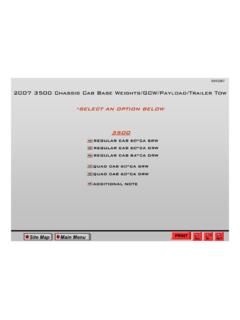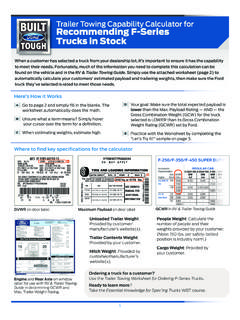Transcription of Improved estimates of the Saturn V velocity and its ...
1 1 Improved estimates of the Saturn V velocity and its ability to place the stated payload into lunar orbit S. G. Pokrovsky, Candidate of Technical Sciences General Director of scientific-manufacturing enterprise Project-D-MSK Abstract In the paper [1] an assessment was carried out of the Saturn V booster and the Apollo 11 spacecraft velocity at first stage separation point based on the motion picture film footage and still photographs. The estimate obtained was that the velocity achieved was significantly (800-1100m/s) lower than that required to satisfy the flight plan for propelling this mission to the surface of the Moon. Further study concludes that no more than 28 tons, including the Apollo 11 craft, out of 46 tons as stated by NASA could have been placed into lunar orbit. Introduction Over the past year, after writing the first paper, some comments have been received and clarifications requested. As a result, a few models have been adjusted, and so the estimates are re-presented here simply and clearly.
2 In addition, it became clear that concepts such as supersonic flows, shocks and shock waves even for readers with background in natural science and with technical education can appear rather vague. These concepts were introduced in a rather formal and mathematical way. Therefore for this paper the physical meaning of the conceptual apparatus used in the original assessment is presented. Contents of the paper [1] In [1] a description of the film footage [5] was provided. The sequence with a duration of 30 seconds (according to the timer) contained 726 frames, which corresponds with a filming speed of 24 frames per second. The frames were numbered consecutively from beginning to end. The first 165 frames (~ 7 seconds) record the flight of the Saturn V rocket with the main engines of the first stage firing. Thereafter, the smoke exhaust of the engines dramatically contracts. Formation of new exhaust corresponding to the second stage solid fuel rockets firing (for fuel ullage) is registered on frame 179.
3 Significant expansion and subsequent hiding of the rocket exhaust cloud occurs due to firing of the first stage solid propellant retro-rockets is recorded on frame 189. After frame 210 the exhaust cloud of the expended solid propellants begins to reveal the head section of the rocket, the exhaust cloud is now braking and starting to lag. Around frame 266 the glow to the aft of the second stage grows brighter. This is three seconds after the start of separation, and the second stage motors reach nominal thrust. This occurrence is in accord with the published flight sequence. Specified time markers spanning frames 179 to 266 covering the firing of ullage and retro rockets, reaching the nominal thrust from the second stage liquid propellant engines in [1] were used to confirm the correctness of relying on the filming speed of 24 fps for time measurement. 2 During further movement of the lead part and first stage we noted inadequate lag of the first stage from the second stage.
4 The distance between the stages over the 13 seconds following the separation extended approximately three times the leading part, approx 180m. However, there was no emphasis on contradicting the data regarding the flight sequencing and the observed operation of the second stage engines in the original paper. This has been addressed. The main purpose of the study was the evaluation of the velocity of the Saturn V at separation. It was regarded as insufficient. Abstract: A frame-by-frame examination of the motion picture film footage of the first stage separation of the Apollo 11 Saturn V rocket was made. The velocity achieved at the separation point was found to be significantly (800-1100m/s) lower than that required to satisfy the stated flight plan. This finding implies that the declared payload needed for a return lunar mission could not have been propelled to the Moon. Selected data about shocks (shock waves) Imagine that a closely fitting piston is moving in a long cylinder and pushing air ahead of itself.
5 At low speed, about 70 m/s, compressed air in front of a piston is negligible. The velocity of molecules is much higher than the piston velocity . Momentum transferred by the piston to the molecules is transmitted to an increasing number of air molecules. The speed of this signal transfer (disturbance) is the speed of sound. With increasing velocity of a piston to 70-100 m/s air compression in front of the piston is already difficult to ignore. Molecules still have a velocity greater than the speed of the piston, but this excess is not large. Air begins to show significant flexibility. A further increase in speed leads to a rapid increase in resistance. A significant layer of air ahead of the piston will "know" that the piston is moving. After one second, one way or another, the molecules at a distance of 330 meters from the piston will start to move. When the piston exceeds the speed of sound a qualitatively new phenomenon appears a shock.
6 The piston is now moving faster than molecules can send traffic between each other. A "plug" of compressed air forms between the piston and the undisturbed air. In front of the shock the air does not know that momentarily it will be moved. After the shock, the air moves at the speed of piston. But how do the front layers know that they are being pushed from behind? The air in the "plug" is not only compressed but also warmed up. The speed of sound in hot air rises in proportion to the square root of the temperature. For front layers to know for sure the speed with which they should move, a prerequisite is a pretty good equation of speed of sound in a plug to the speed at which piston moves. The described shock is called a normal shock the flow is perpendicular to the front of the shock. Continuous change in the physical parameters of the gas (pressure, density, temperature, speed) occurs at very short distances, compared to the mean free path of molecules.
7 Table 1 shows the calculated depth of a shock, divided by the mean free path of molecules in undisturbed gas depending on the ratio of the pressure behind the shock to the pressure of undisturbed gas [2]. Table 1. Depth of the shock p2/p1 2 5 10 50 100 1000 d/ 3 Such an abrupt change of parameters in most cases in practice is very well mathematically described as an abrupt discontinuity. Before a shock, intact gas has no directional velocity , it has the density, pressure and temperature of the undisturbed air. After this surface of the shock front, ALL molecules acquire the velocity of directed motion. Density, pressure, and temperature rise. In practice fast flying bodies such as a shell or a bullet act in place of a piston. It could be compressed gas emanating from a cylinder, a jet engine, a rifle or a gun barrel, resulting in an explosion. A normal shock, which is formed in such cases, has another name a shock wave.
8 A shock wave is not usually visible. But it can be made visible in experiments, for example, by using so-called shadow and interference techniques (Image 1). Image 1a Image 1b Image 1. Interference a) [3] and shadow b) [4] pictures of shock waves. In the case of a nuclear explosion the shock front coincides with the boundary of the expanding luminous region. The shock front in some cases may also group airborne smoke particles and become visible as a result. Let us examine this case because it is important. A) If a shock wave hits the air with smoke particles then air molecules begin to move at the speed of the shock. They also carry along fine aerosol particles that make up the smoke cloud. Later the captured shock wave molecules are displaced rearwards from the front, yielding space to the new ones. But speed of this flow is only slightly less than the speed of the shock. Therefore, smoke particles are pinned to the front, and housed together with the co-current flow of compressed air at a short distance behind the shock wave.
9 Accordingly they decorate it. B) In another example of a typical explosion, the smoke particles arise in the explosion itself and fly away with the explosion gases. Only massive bodies with large inertia can outrun the slowing explosion shock. Nanometer-sized smoke particles fly at virtually the speed of the gas flow. Conversely, a shock wave can detach from the smoke and progress due to the capture of more and more new layers of undisturbed air and the lagging co-current flow containing smoke particles. In this case, if the speed is determined based on the moving smoke, the estimate is conservative. The speed of the shock is slightly higher. The above facts are sufficient in order to understand one method of velocity calculation. 4 Speed estimate based on a diameter of the smoke cloud front At the booster Saturn V staging, the solid fuel retro-rockets are fired emitting a cloud of smoke in a forward direction. This cloud outruns the rocket and hides it for about sec (Image 2 below).
10 Consequently, the speed of smoke in this case is not lower than the speed of the rocket. The rocket speed must be supersonic. Therefore, the smoke cloud is spreading forward along the rocket course not like a usual cloud, but following the shock wave. The speed of the shock wave is even higher. A moving shock wave necessarily evolves into movement at its own speed along with all the air molecules. But, lagging behind the shock the molecules are slowing down; their acquired kinetic energy dissipates and transforms into heat. The very area covered by the moving air expands in a radial direction. And momentum gained by molecules in the shock is redistributed into this ever-increasing mass of air. Both energy and momentum gained by the molecules of undisturbed air when crossing the shock front originate from the energy and momentum of the one ton of the solid fuel exhaust gases, which are ejected from the nozzles of the eight retro-rockets.





